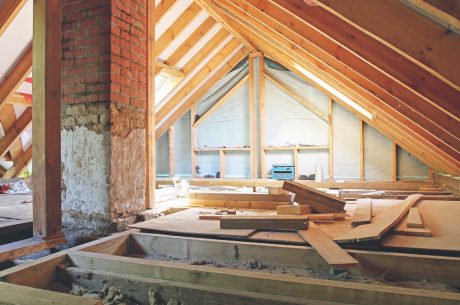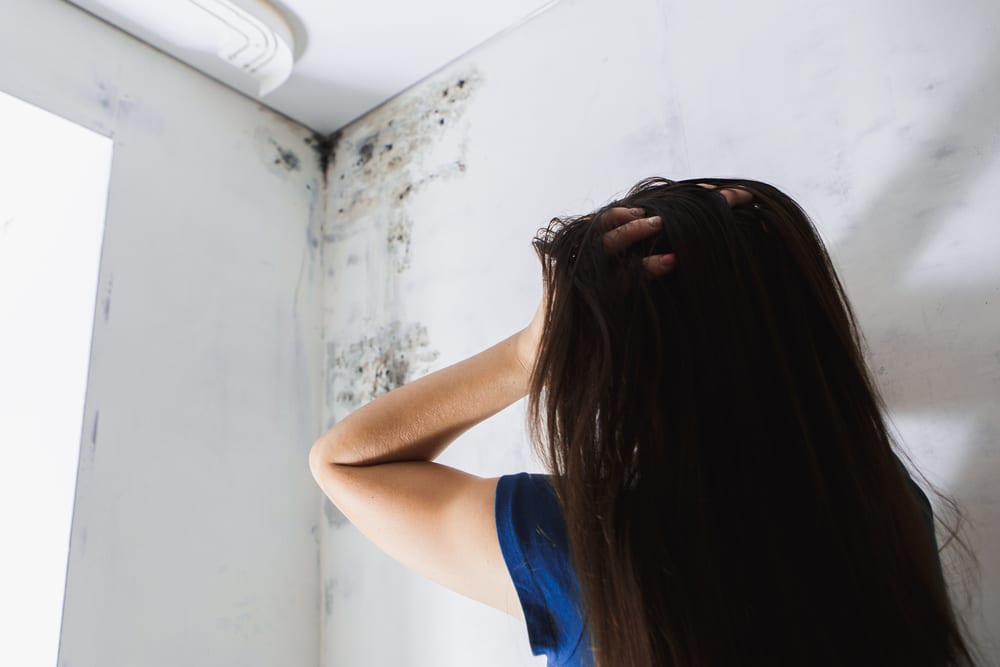Spring is here! Really, it feels more like summer already, but after a record-breaking winter, it’s safe to say most of us are happy about the warmer temperatures. This means beautiful greenery, chirping birds, and blooming flowers. However, the return of those beautiful blooms often brings, for many, allergies as well.
For anyone who has suffered from allergies, we know it’s not fun. But what many people don’t know is that mold can play a role in seasonal allergies, too.
Allergens from mold can linger in the air for months due to increased humidity. We should be aware of our surroundings and enact the necessary preventative measures if we are among the unfortunate who endure seasonal allergies.
What Is Mold and Where Is It Found?
Mold is a type of fungus that is part of the ecological system that mother nature uses to break down organic materials and turn them back into soil and fertilizer for plants. Think of mushrooms. They grow in environments where there are cellulosic organic materials and excess moisture. Mold can grow indoors or outdoors. It’s the spores of the mold that, when released into the air and inhaled, people can react to, particularly those who are more sensitive. In one instance, we found mushrooms growing in a bedroom! That’s getting a bit too close to nature for our taste.
Unfortunately, the similarities in symptoms can make it hard to distinguish allergies from mold sensitivity, as both can cause congestion, sneezing, postnasal drip, coughing, and more. Since mold thrives in warmer conditions when humidity is higher, this can increase the rate at which it grows. In turn, this can exacerbate symptoms in some individuals during the spring months. Mold allergies can be especially problematic during spring when the weather is warm and humid. In fact, the warmer temperatures and increased moisture in the air can cause mold to grow and spread rapidly. This means that people allergic to mold may experience more severe symptoms during the spring months.
If Mold Is Outside, Where Is It Usually?
It’s easier to escape from some elements indoors, but what of mold outdoors? Since mold grows in moist areas, wet soil, leaf piles, and the underside of fallen trees are excellent candidates. As organic materials break down, it creates the ideal conditions for mold to grow. Lichen is a good example of this.
What About Inside?
It would make sense that mold growing indoors can also contribute to seasonal allergies. It can seriously threaten your health, especially if left untreated. You may not even realize mold is present in your home, as it can hide behind walls and carpets. The presence of mold inside your home can cause allergy symptoms and damage your home’s structure and furnishings. Mold can grow on any organic material, including paper, fabrics, and wood. Over time, this can lead to the deterioration of these materials and can cause permanent damage to your home.
In addition, indoor mold can create an unpleasant and musty odor that can be difficult to remove. If you suspect mold in your home, it is important to take action quickly to prevent further growth and potential health hazards.
What Are the Symptoms Specific to Mold Exposure?
As previously stated, due to the similarities between symptoms caused by allergies and symptoms caused by mold exposure, discerning one from the other can be challenging. According to the Asthma and Allergy Foundation of America, many mold allergy symptoms are similar to those of other allergic reactions, such as hay fever or asthma symptoms. It’s important to also take note of when such symptoms are at their worst, or when they are absent altogether. An example of this is when someone is experiencing a cough, congestion, and/or fatigue, but they find that when they leave their home for a period of time, the severity of the symptoms decrease.
If you believe that mold may be the cause of your symptoms, speak with your primary care physician. They can refer you to an allergy specialist, who performs tests to determine whether or not you have a mold allergy. They’ll also recommend the best course of treatment for your symptoms.
While mold may be a nuisance for some people, it can pose serious health risks for sensitized individuals with weakened immune systems or pre-existing health conditions. Mold exposure can trigger allergic reactions and asthma attacks, especially in people prone to these conditions. Additionally, prolonged mold exposure may lead to more severe health effects, such as respiratory problems, skin irritation, and even neurological symptoms in some cases.
For example, individuals with chronic lung conditions, such as asthma or chronic obstructive pulmonary disease (COPD), may experience worsening symptoms when exposed to mold. Mold exposure can also lead to fungal infections in individuals with a vulnerable immune system, such as those with HIV/AIDS, cancer, or people who have had organ transplants.
Additionally, exposure to certain types of mold, such as Stachybotrys chartarum, Aspergillus, and Cladospurium, commonly known as black molds, have been linked to various health effects, including headaches, fatigue, and even memory loss.
In some cases, exposure can also cause skin irritation, such as rashes or hives. People susceptible to mold may also experience neurological symptoms like headaches, dizziness, or difficulty concentrating. These symptoms may be more common in people exposed to high mold levels for an extended period of time.
It’s important to note that not all molds are toxic, and not all people will experience health effects from mold. However, it’s always better to err on the side of caution and take steps to reduce your mold exposure, especially if you are at higher risk for health complications.
What to Do About Springtime Mold Allergies
If you believe that mold is the cause of your seasonal discomfort, there are several steps you can take to reduce and eliminate your exposure. The following tips will ensure your home remains mold-free during the placid spring season.
- Clean regularly. Regular cleaning of your home can help prevent the growth of mold. Use disinfectant to clean surfaces in damp areas like the bathroom and kitchen, and vacuum carpets and upholstery frequently to remove mold spores.
- Control indoor humidity. Mold loves damp environments, so controlling the moisture in your home is crucial in preventing mold growth. Keep your home’s humidity levels below 50 percent using a dehumidifier or air conditioner.
- Use an air purifier/filtration system. Air purifiers are an excellent way to help reduce mold spores in your home. Not only do they remove polluted air, but they also help to filter out small particles of mold-causing substances like dust and pollen. Regular use of an air purifier will even help prevent mold spores’ future growth, allowing you and your family to avoid breathing in harmful mold particles that could make you sick over time.
- Address leaks promptly. Leaky pipes and other appliances can quickly lead to mold growth if left unaddressed. If you notice any leaks, fix them as soon as possible to prevent mold from growing.
- Remove mold immediately. If you spot mold in your home, removing it as soon as possible is essential. Wear gloves and an N95 or P100 mask/respirator to protect yourself, and clean the moldy area to the best of your abilities using an EPA-approved fungicide/disinfectant.
- Consider professional help. Hiring a certified mold remediation professional to remediate any mold issues in your home may be necessary in many cases. This is especially true if you have a large mold infestation or if the mold is hidden behind walls or in other hard-to-reach areas. A professional mold remediation company can assess the extent of the problem, remove the mold safely and effectively, and take steps to prevent it from returning.
What About Outdoor Mold?
It might sound like a straight-forward solution, but one way to avoid mold growth outdoors is to take care of your yard. This means removing any debris (particularly after the winter season) and keep your gutters clean to prevent water from pooling around your home’s foundation.
If you’re working outside in your yard, wearing a mask is helpful; this can aid in preventing the inhalation of mold spores. It should fit securely over your nose and mouth and have a high-efficiency particulate air (HEPA) filter to capture even the tiniest mold spores. Be extremely careful around damp soil and piles of leaves, as they are most likely to have mold. Stay in open and well-ventilated spaces.
If you live in an area with high humidity, consider using a fungicide to help prevent mold growth. It’s also a good idea to keep your windows and doors closed during high pollen and mold count days, so monitor your daily weather report. Additionally, if you enjoy outdoor activities like camping or hiking, check the weather before heading outside and avoid areas with high mold counts.
To further help combat the effects of springtime molds, you may also consider taking over-the-counter allergy medication to relieve bothersome symptoms such as sneezing and a runny nose. As always, please consult with a medical professional prior.
While pollen may be the most well-known allergen during spring, mold can also cause seasonal allergies. However, with the proper precautions, you can reduce mold exposure and alleviate your symptoms. If you suspect your spring allergies are mold-related, speak with your doctor about allergy testing and treatment options. Remember that prevention is key when it comes to mold allergies, so take steps to keep your home a healthy and safe place.
Call PuroClean of South Reno for All Your Mold Remediation Needs!
Don’t let mold be the cause of your property destruction. With the reliable, experienced, certified team at PuroClean of South Reno, you can quickly get the help you need to fight off any signs of mold in your home or business. As strange as it sounds, mold remediation is kind of our bread and butter.
Here at PuroClean of South Reno, we understand there is no time to waste when it comes to mold growth. We provide emergency services 24 hours a day, seven days a week. As the “Paramedics of Property Damage®,” rest assured that we are here for all your mold removal needs! Call us today at (775) 446-4646.



